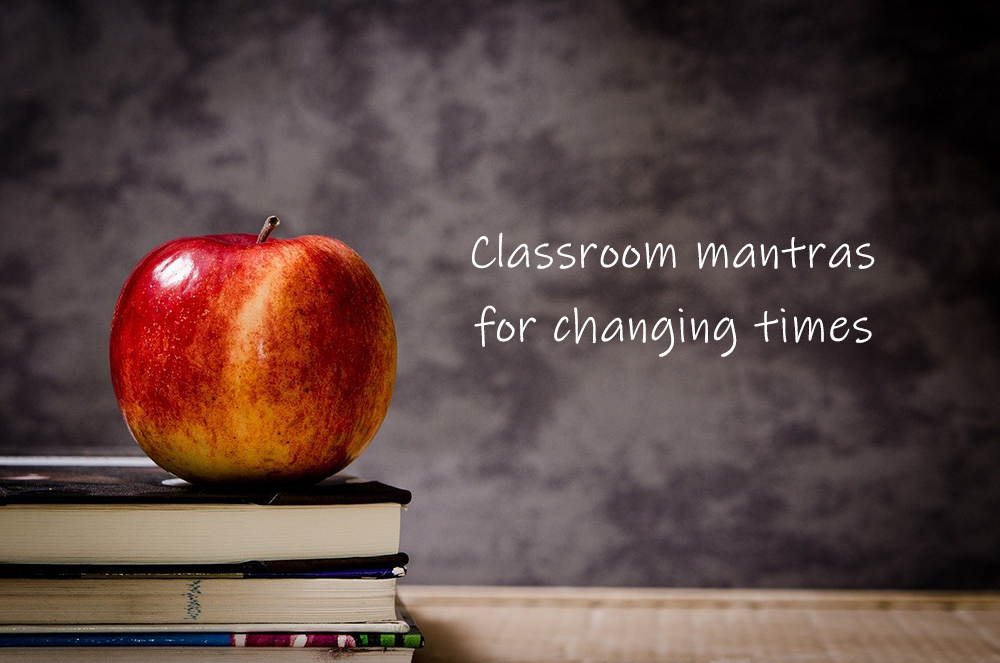
Classroom mantras for changing times
By: Tiffany Wincek, Product Liaison
I refuse to believe September is almost over.
In childhood, the beginning of any new school year brought excitement colored by anxious chaos: finding a new backpack with an adequate number of perfectly sized pockets, stressing about being forced to use pencils in math class, and showing up to school in stirrup pants when everyone else cosmically knew the age at which one naturally transitions to jeans.
In retrospect, I suspect these scenarios were uniquely my own, but at least I knew back then that “hard pants” were for the birds. While I had full control over which writing utensils I was allowed to use when I became a teacher, I can’t say a new school year didn’t send me searching for the perfect work bag or lamenting the impending doom of professional trousers.
Yes, the back-to-school season is always unmistakably disordered. This school year, however, the level of chaos seems to exceed all others, at least in North America. Educators and students alike are all reeling from the pandemic’s impact on health, learning progress, school policy, and so much more.
I first wrote about classroom mantras on this blog back in August of 2018, in what we might call “slightly simpler times.” While the mantras I offered then (appreciation, connection, effort, innovation) are still fine choices today, perhaps it’s time for the remix. Having a go-to classroom mantra may be more worthwhile now than ever.
Whether your school year started in August, September, January (we see you, international friends!), or a different month, we hope one of the following words resonates with you and helps frame your perspective.
Patience
With your students, with yourself, with the mystery colleague who left the copy room without fixing the copier jam because his students were waiting…patience is not only a virtue, but also a mood-shifter. The incoming freshmen of 2022 are unlikely to enter your classroom with the same mastery you might have expected in 2018. Impatience will only lead to more frustration. Everyone could use a little grace. Patience is also a great reminder to allow students enough time to process questions—someone may always raise their hand first, but make space for those still organizing their thoughts.
Listen
I like this mantra because of its broad applications: listen to the inner voicing telling you to change the direction of a lesson when students are disengaged; listen to your colleagues when they describe which strategies are working well for their students so you can implement their best practices; most importantly, listen to your students. They may have experienced things over the past several years that could forever impact their learning; they may be eager to share interests, memories, or challenges that could fundamentally change how you connect with them. Be open to these bids for connection. Listen to understand instead of respond, and—should you hear something that needs correcting—do so with compassion.
Balance
When you reflect on your teaching philosophy, what role does homework play? The conversation about homework’s helpfulness or harmfulness is not new, and a growing number of schools are banning or severely limiting homework. If you must assign homework, evaluate how well it balances your in-class instruction in addition to how it balances with student life after school. Practice is no doubt valuable, but could 10 problems supplant 50? If you only plan to collect and grade specific assignments instead of reviewing them in class, are you providing timely and effective feedback? Striking a good balance of work for your students means better balance for you, too.
Together
Have you ever worked with the kind of teachers who seem to pit students against each other, the teacher, or both? They always baffled me; antagonists aren’t a good fit for the classroom unless you’re teaching about characterization. A classroom with a “together” mantra evokes warmth, connection, and perseverance. It makes room for tough days. It laughs in the face of suspensions and outdated policies that extract students from learning rather than galvanizing a sense of belonging. It means it’s okay to say, “I don’t know, but I’ll find out,” even if you’re the educator!
Challenge
I shall be telling this with a sigh: I debated including “challenge” in this list because it evokes a road frequently traveled in 2022. It’s currently Banned Books Week 2022, yet book challenges are commonplace in the daily news cycle and students are losing access to content at an alarming rate. This is another mantra with broad usage appeal. Instead of challenging books, challenge your students by adding gamification to lessons that once relied on direct instruction—crafting competitive and interactive assessments for students offers a personal challenge to you, too. Create a reading challenge. Challenge yourself to involve more student ideas into lesson planning. Most importantly, hold fast to the knowledge that books with controversial themes let students navigate adversity via literature in lieu of personal experience. From a safe distance, stories build students’ empathy, problem-solving skills, and understanding of history, and we should challenge ourselves to empower every student with the books that are right for them.
Which mantra resonates the most with you? Do you have one of your own? If so, do you keep it private, share with colleagues, or use it to unite your classroom? If you adopt a mantra for your classroom, we’d love to learn more! Share your thoughts with us on Twitter.
About the Author:
Tiffany Wincek, the Product Liaison for OverDrive Education, taught in New York public schools for 10 years prior to joining Team OverDrive. She holds degrees in English, education, and literacy and loves making authentic connections with and providing solutions for OverDrive partners. In her spare time, she enjoys reading, baking, lifting heavy things, and listening to nothing but Nothing But Thieves.
Tags In
Browse blog and media articles
Public Library Training
K-12 Library Training